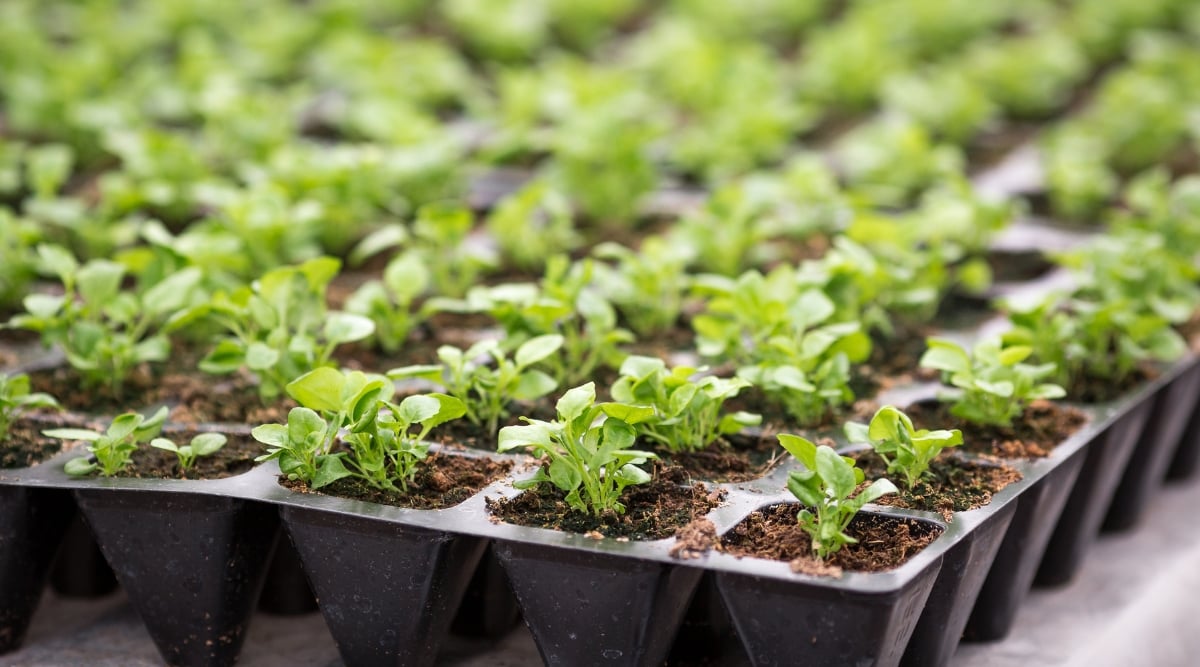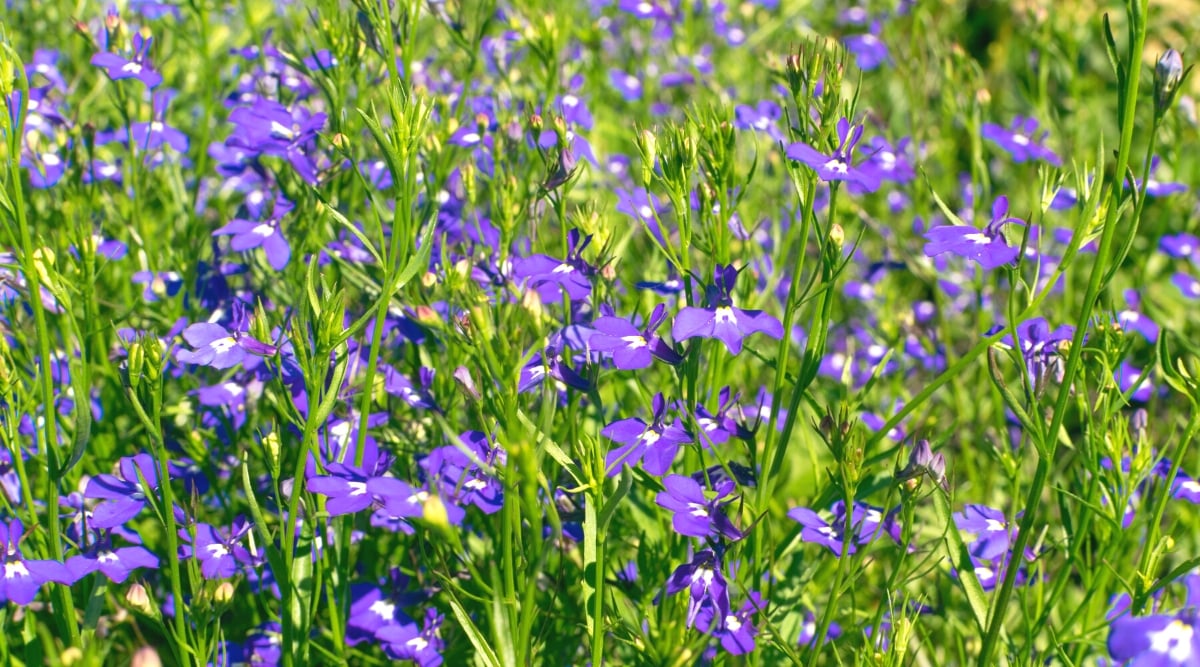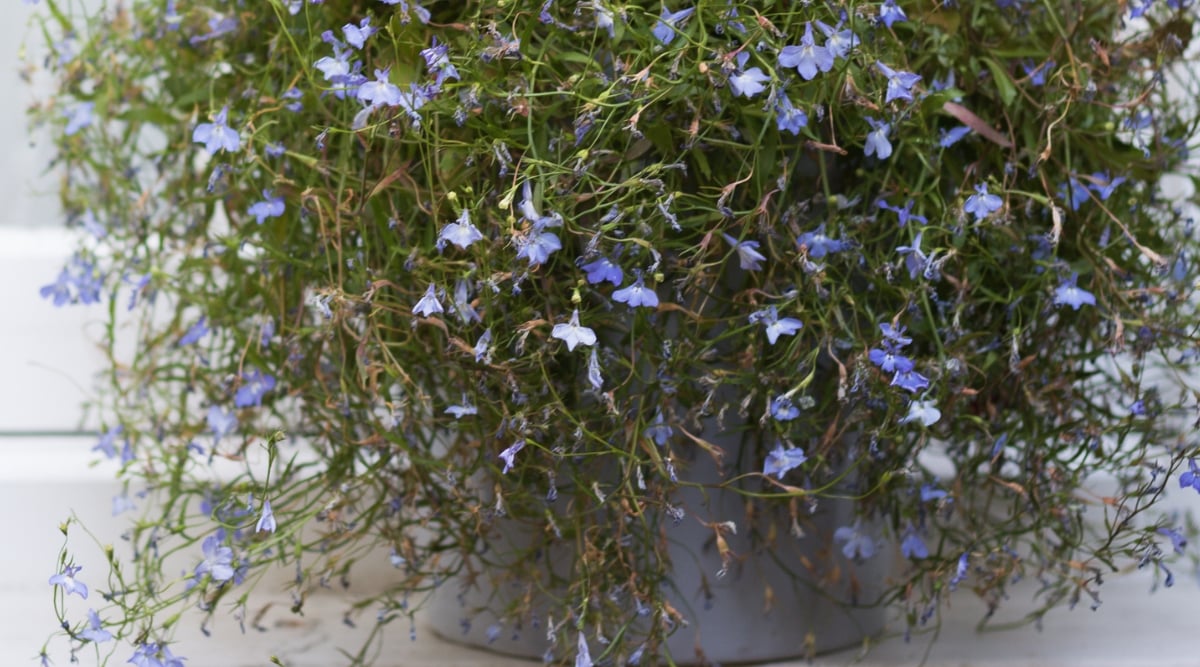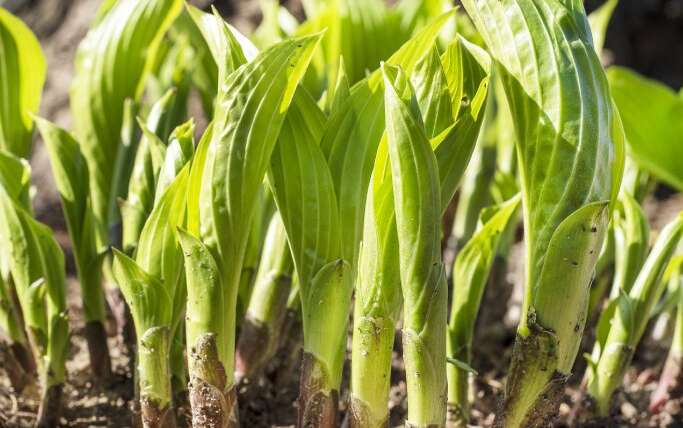If your garden needs more cool-weather flowers blooming through spring and fall, lobelia is a gorgeous, low-maintenance plant. The striking clusters of three-petaled flowers and central white “eyes” create an impressive floral display in ornamental beds, rain gardens, hanging baskets, and containers. Growing these tender plants is a breeze and rewards you with an abundance of deer-resistant, pollinator-attracting flowers.
The genus Lobelia encompasses a wide range of ornamental and wildflowers, namely L. erinus, the trailing tender perennial known for its cobalt-blue flowers. True blue is a rare color in the plant world, making this variety extra special in the garden. But you will also find lobelias in lilac, rose, burgundy, sky-blue, and tropical floral colors. There are hundreds of Lobelia species, some performing best as warm-weather annuals and others as hardy marshy perennials.
Let’s dig into everything you need to know about caring for lobelia in nearly any garden setting!
Lobelia Plant Overview
| | |
History and Cultivation
 Lobelia plants have a wealth of diversity, with mounding, trailing, and tall varieties available.
Lobelia plants have a wealth of diversity, with mounding, trailing, and tall varieties available.
With such diverse floral offerings, lobelia plants bring a rich botanical history to your garden. There are mounding, trailing, and tall-growing varieties, some remaining perennial and others growing as annuals in temperate zones.
You may grow the hardy wild lobelias native to the United States to attract hummingbirds or plant tender tropical lobelias that cascade from hanging baskets on partially shaded patios. No matter your selection, this easygoing group of plants yields intriguing two-lipped tubular flowers and attractive foliage.
What is Lobelia?
 With 400+ species worldwide, including red, white, orange, and pink blooms, they were named after Flemish botanist Matthias de Lobel.
With 400+ species worldwide, including red, white, orange, and pink blooms, they were named after Flemish botanist Matthias de Lobel.
Lobelia is a genus of flowering plants in the bellflower family, also known as Campanulaceae. It is most well-known for its various hues of sky-blue and cobalt-colored flowers, which are remarkably rare in botany. Less than 10% of flowering plants have blue blooms, including blue hydrangeas. The distinctly lipped flowers also come in red, white, orange, and pink.
With over 400 species, lobelias are a diverse group of plants native to regions worldwide, including Africa, Asia, and North and South America. The genus got its name from the Flemish botanist Matthias de Lobel, who first identified the tobacco-like qualities of the low-growing plant in Flanders, Belgium. Native Americans used the plant for its herbal qualities.
Where Does Lobelia Originate?
 This perennial flower, found on every continent except Antarctica, is most diverse in Australia and Africa.
This perennial flower, found on every continent except Antarctica, is most diverse in Australia and Africa.
Lobelia species are native to every continent except Antarctica, but the most diversity is found in subtropical and tropical regions in Australia and Africa. Over 30% of all lobelias are native to Africa, including L. erinus, the most popular spring flower in garden stores.
The North American native wildflowers, Lobelia cardinalis, and L. siphilitica, were notably used by indigenous Penobscot and Cherokee tribes for medicinal purposes. In the 18th and 19th centuries, lobelia plants spread from the Americas and Africa to Europe, becoming popular ornamental plants in cascading basket displays and royal flower gardens.
Propagation
Depending on the local availability of your desired species, you can grow these striking flowers from seeds, cuttings, or transplants from the garden store. Most varieties should be planted in spring when the weather has thoroughly warmed. You must plan up to 12 weeks in advance if growing from seed.
Seed
 To cultivate this perennial, plant seeds indoors 10-12 weeks before transplanting, using a moistened seed-starter mix.
To cultivate this perennial, plant seeds indoors 10-12 weeks before transplanting, using a moistened seed-starter mix.
You can cultivate this dazzling flower from scratch, but it will require some patience. The tiny lobelia seeds take several weeks to germinate and need special handling. Start indoors 10-12 weeks before you transplant in the garden.
Here is what you’ll need:
- Lobelia seeds
- Well-drained seed-starting mix
- Small pots or cell trays
- Plastic wrap or clear plastic dome (to boost humidity)
- Grow lights or a south-facing window with indirect, bright light
- Watering can or spray bottle
- Diluted balanced fertilizer
Fill your pots or trays with a lightly moistened seed-starter mix and thinly sow the seeds on the surface. Barely press them into the soil, and do not cover them. They need light to germinate.
Use a gently spray-nozzle watering can or misting bottle to moisten the soil without disturbing or moving the seeds. Cover the container with plastic wrap or a clear dome to maintain consistent humidity. Ensure there are still holes for airflow. Otherwise, your seeds could be susceptible to damping off disease.
Place the seeds in an area with bright, indirect light or under a grow light. Room temperatures between 65 and 70°F are perfect. Germination takes 14-20 days, but a heated germination mat may help speed up the process.
Cutting
 To propagate this perennial plant, take softwood cuttings from healthy, non-flowering stems in the summer.
To propagate this perennial plant, take softwood cuttings from healthy, non-flowering stems in the summer.
Many species of this genus can be propagated by cutting. If you or a friend has an established lobelia plant, this is an easy way to multiply your collection for free. The best time to take softwood cuttings is in the summer.
This method is most common with the blue or purple trailing lobelia (L. erinus) but also works with native species like L. cardinalis or L. siphilitica. This process will be very familiar if you have ever rooted petunia cuttings.
Only a few supplies are necessary:
- A healthy lobelia plant with non-flowering stems
- Sharp, sanitized garden pruners
- Propagation or seed-starting mix
- Small pots or cell trays
- Misting bottle
- Grow lights or a bright window
- Rooting hormone (optional)
Find a long, healthy stem with several sets of leaves and no flowers. Flowering stems are not viable for cuttings because the plant puts its energy toward floral production rather than roots. Green new growth is the best for propagation because it is young, pliable, and has many stem cells ready to grow into roots and shoots.
Take a cutting about 4-6 inches long, making your cut just beneath a node. Nodes are the little bumps where the leaves intersect with the stem. Strip the lower 1-3 inches of leaves.
Fill your containers with a moist, well-drained mix and place the cutting in the soil, burying about half the stem. Optionally, you can dip the tip of the cutting in a rooting hormone before planting to speed up the process and prevent rot.
Keep cuttings in a protected area (preferably indoors) with an optional humidity dome. The soil should be consistently moist but never soggy. When new foliage starts to form, and there is resistance when you gently tug the cuttings, they are rooted. Lobelia cuttings usually take 24 to 30 days before they are ready to transplant, so take a bunch at once!
Division
 Dig up the root balls and cut them into clumps to divide this perennial plant in the spring. Allow them to establish before winter.
Dig up the root balls and cut them into clumps to divide this perennial plant in the spring. Allow them to establish before winter.
Perennial lobelia species can be divided in the spring by digging the root balls and cutting them into clumps. This ensures the plants have the entire growing season to establish themselves before the cold sets in.
To divide your lobelia:
- Water the plant a day or two before division.
- Moistened soil will make it easier to lift and separate the roots without damaging them.
- Carefully dig around the plant’s base with a garden fork or shovel.
- Lift the plant from the ground.
- Use a sharp, clean knife or pruners to carefully separate the root clumps into sections.
- Ensure each 4-6” section has plenty of roots and foliage.
- Prune away any damaged or unhealthy parts of the leaves and roots.
- On the same day as dividing, transplant new clumps into containers or a new bed.
- Replace the original plant and backfill the soil.
- Ensure the planting holes are deep enough for the roots to spread.
- Plant at the same depth and gently fill the hotels with soil.
- Keep new divisions consistently moist and add a bit of all-purpose balanced fertilizer.
Division is a great way to thin out an overcrowded stand. Overcrowding can cause competition for nutrients, water, and sunlight, leading to plant stress or disease. Use the spacing guide below to ensure the plants can grow to their full glory.
Planting
Whether you purchased an established nursery plant or started your own lobelia, the transplanting process is very straightforward.
How to Transplant
 For this plant, choose spring for transplanting, avoid peak summer heat, and ensure well-drained soil with compost.
For this plant, choose spring for transplanting, avoid peak summer heat, and ensure well-drained soil with compost.
The best time to transplant is in the spring when the risk of frost has passed. If growing in a container, you can plant a little earlier as long as the arrangement is protected. Avoid planting in the peak heat of summer, or the plants will become stressed.
Choose a location with well-drained, moist soil and plenty of compost. Cardinal flower lobelia is an exception to this rule because it tolerates marshy, streambank areas. Thoroughly hydrate the seedling a day or two before transplanting to reduce the risk of transplant shock.
Dig a hole about twice as deep and wide as the existing rootball. Gently loosen the plant from its nursery pot and place it in the hole, maintaining the same soil level. Backfill the hole and lightly tamp down to secure the plant. Maintain continuous moisture during the first few weeks to help it get established.
Optionally, mulch perennial lobelias to suppress weed competition, retain soil moisture, and add extra warmth.
Spacing
 Spacing requirements for these perennial flowers vary by species.
Spacing requirements for these perennial flowers vary by species.
The spacing required for these flowers varies widely between species. Close spacing can create big, lush clumps of foliage and flowers, but planting too close can cause disease issues or stunt plant growth. Depending on your garden bed or container size and variety, you may need to experiment.
Here are the general spacing needs for each type of lobelia:
- Upright lobelia (L. erinus): 6-8 inches apart, dense plantings look great in containers
- Trailing lobelia (L. pendula): 8-12 inches apart in hanging baskets
- Cardinal flower (L. cardinalis): 12-18 inches apart. Taller plants are great for borders
- Indian tobacco (L. siphilitica): 12-18 inches apart, perfect for native woodland gardens
How to Grow
Growing lobelia is very straightforward, and the plants don’t usually have many issues. The native species are the most hands-off, while the tender perennials require a little more maintenance to keep them blooming in container or basket displays.
Light
 For these perennial plants, aim for partial to full sun conditions, providing 4-6 hours of direct sunlight daily.
For these perennial plants, aim for partial to full sun conditions, providing 4-6 hours of direct sunlight daily.
Partial to full sun is ideal for almost all lobelias. Ensure your plant has at least 4-6 hours of direct sunlight daily and some afternoon shade in hot climates. Cardinal flowers and Indian tobacco tolerate more shade and can thrive in woodland areas.
When selecting your planting location, consider how the sun moves over the area throughout the day and season. For example, a hanging basket on an east-facing porch will receive lots of morning sunlight and afternoon shade, which is excellent for a longer flower display. Too much intense afternoon light can wither the fragile flowers and dry out the potting mix more quickly.
If growing clumping or trailing varieties in the ground, plant them alongside other low-growing plants so they don’t get completely shaded out or baked by the hot sun.
Water
 To keep these flowering plants healthy, maintain consistently moist soil and avoid letting it dry out fully.
To keep these flowering plants healthy, maintain consistently moist soil and avoid letting it dry out fully.
Lobelia needs consistently moist soil. You should never let these plants dry out! For container-grown lobelia, water 2-3 times per week after checking the soil moisture. If the top inch is dry, it’s time to give your flowers a drink. Drainage is also important so the plant roots don’t become soggy or rotten. Perlite and vermiculite ensure water doesn’t pool inside a pot or basket.
Native species particularly need moist to wet soil, as they thrive in marshy areas. They need water once or twice a week during establishment. Still, waterlogging can cause rot issues, so take care not to over-irrigate, especially if you live in a rainy climate.
Soil
 Use well-drained, loamy soil enriched with compost or quality potting mix, and ensure good soil aeration.
Use well-drained, loamy soil enriched with compost or quality potting mix, and ensure good soil aeration.
Loamy, well-drained soil is ideal for this plant. Amend with compost or a high-quality potting mix to yield the brightest flower display. Before planting, loosen the soil with a garden fork or your hands.
If your soil has poor drainage, add peat moss, compost, perlite, or vermiculite so the roots can breathe properly. In a container, a standard flower potting mix works great.
The pH can range from 5.8 to 7.0, with most species preferring slightly acidic soil. A layer of shredded straw or leaf mulch can protect the soil from drying out and help reduce weed competition while simultaneously moderating the soil temperature.
Climate and Temperature
 These perennial flowers thrive in mild temperatures between the 60s and 70s.
These perennial flowers thrive in mild temperatures between the 60s and 70s.
These flowers enjoy nice mild temperatures in the 60s and 70s. Most lobelias are native to subtropical and tropical regions of the world, meaning they are only tender perennials in most of the United States.
For example, the popular L. erinus (trailing blue lobelia) is usually grown as an annual flower in spring and fall. It cannot handle temperatures below 40°F and typically stops flowering when temperatures dip below 50°F.
If you want a more cold-hardy variety, Lobelia x speciosa cultivars are perennials hardy to a whopping 5°F. Similarly, the North American native species Indian tobacco and Cardinal flower can handle negative temperatures during their dormant phase and still grow back the following year.
Remember that these are usually herbaceous perennials, so they die back to the ground at frost and regenerate their foliage in the spring. Mulching can help protect the root clumps through harsh winters.
Fertilizing
 A balanced all-purpose fertilizer works well, but avoid excessive nitrogen to prevent excessive foliage growth.
A balanced all-purpose fertilizer works well, but avoid excessive nitrogen to prevent excessive foliage growth.
A balanced all-purpose fertilizer is perfectly fine for these two-lipped blossoms. The plants are not particularly demanding about nutrients as long as they don’t get too much nitrogen. Excessive nitrogen causes an overgrowth of lush foliage at the expense of flowering.
A diluted slow-release organic fertilizer can be applied in the spring and every 3-5 weeks during the growing season. Nutrients leach out of containers more quickly, so you may need to fertilize every 2-3 weeks. If you plan to overwinter your perennial lobelias, stop fertilizing the fall to allow the plant to prepare for dormancy.
Follow package instructions carefully and apply diluted fertilizer directly at the soil level. Never put fertilizer on the plant’s foliage, or it may burn them.
Maintenance
 The trailing types need the least pruning, while upright varieties benefit from regular pruning.
The trailing types need the least pruning, while upright varieties benefit from regular pruning.
These low-maintenance plants don’t need to be tended to super often. Trailing varieties need the least pruning, while upright cultivars benefit from regular pruning of straggly growth.
Consistent deadheading encourages the most prominent, neatest flower displays. Deadheading redirects plant energy toward producing new blossoms rather than going to seed. When flowers fade, pinch them off or cut them with pruners at the stem base. Remove any dead or damaged foliage at this time.
If a plant becomes leggy or overgrown, you can cut back the plants by up to one-third to encourage bushier new growth.
Native Pollinator Plants
 Native plant enthusiasts will appreciate the cardinal flower in their gardens, as it attracts butterflies, bees, and hummingbirds.
Native plant enthusiasts will appreciate the cardinal flower in their gardens, as it attracts butterflies, bees, and hummingbirds.
For native plant fanatics and pollinator lovers, the cardinal flower (L. cardinalis) is a delightful addition to your butterfly, bee, or hummingbird garden.
Plant it alongside other native, moisture-loving flowers like:
- Swamp milkweed (Asclepias incarnata)
- Turtlehead (Chelone spp.)
- Blue flag iris (Iris versicolor)
- Pickerelweed (Pontederia cordata)
- Bee balm (Monarda spp.)
Varieties
The diversity of options in this genus can be overwhelming. First, decide what height lobelia you need:
- Clumping (low-growing): L. erinus or L. puberula
- Trailing (hanging baskets): L. pendula
- Upright (tall border beds): L. siphilitica or L. cardinalis
Next, determine if you’d like it to grow as an annual or perennial:
- L. erinus and L. pendula are tender perennials usually grown as annuals in zones 4-9
- L. cardinalis is a native hardy perennial in zones 3-9
- L. siphilitica is a native clumping perennial hardy in zones 4-8
Here are some of our favorite varieties for the prettiest display:
Upright Lobelia (L. erinus)
 ‘Lobelia Crystal Palace’ is prized for its deep blue-violet flowers and compact growth habit.
‘Lobelia Crystal Palace’ is prized for its deep blue-violet flowers and compact growth habit.
These varieties are most commonly used as bedding, edging, or container plants. They grow 6-12 inches tall and flower all spring and fall.
You can find cultivars with blossoms of every color, but the most popular is blue. My favorites include:
- ‘Crystal Palace’
- ‘Regatta Series’
- ‘Cambridge Blue’
- ‘White Lady’
Trailing Lobelia (L. pendula)
 ‘Lobelia Sapphire’ is known for its striking sapphire-blue flowers and is a favorite for adding vibrant color to hanging baskets.
‘Lobelia Sapphire’ is known for its striking sapphire-blue flowers and is a favorite for adding vibrant color to hanging baskets.
This vining species is ideal for hanging baskets or window planters where the vines can cascade downward. They grow 6-12 inches tall and can spread 12-24” in every direction.
The prettiest container varieties are:
- ‘Sapphire’
- ‘Waterfall Series’
- ‘Fan Scarlet’
Native Lobelia Species
 The cardinal flower is celebrated for its brilliant red blooms and ability to attract hummingbirds to the garden.
The cardinal flower is celebrated for its brilliant red blooms and ability to attract hummingbirds to the garden.
If you want to develop a native planting or start a wildflower garden, these species are indigenous to the United States. They attract lots of pollinators and tend to have a larger growth habit.
- Cardinal flower (L. cardinalis)
- Indian tobacco (L. inflata)
- Great blue lobelia (L. siphilitica)
- Downy lobelia (L. puberula)
Pests and Diseases
While wonderfully deer and rabbit-resistant, lobelia plants sometimes fall victim to aphids, slimy pests, and fungal diseases. Fortunately, they are easy to deal with.
Aphids
 Aphids are garden pests that infest various plants, including ornamental flowers like lobelia.
Aphids are garden pests that infest various plants, including ornamental flowers like lobelia.
These small sap-sucking insects spare no victims in the garden. They attack almost everything, including your ornamental flowers.
If you notice aphids on the undersides of your lobelia leaves, you can wipe them off with a diluted neem solution or spray them with a heavy stream of water, taking care not to damage the flowers. Interplanting with white alyssum and marigolds can help attract biological predators.
Slugs and Snails
 Moisture-loving plants like this often attract slugs and snails that can harm new transplants and create irregular leaf holes.
Moisture-loving plants like this often attract slugs and snails that can harm new transplants and create irregular leaf holes.
Given the moisture-loving nature of this plant, slimy pests often hang out near their base as it provides the ideal conditions for them to thrive. Slugs and snails can cause issues with new transplants and chew irregular holes in the leaves.
Use iron phosphate slug bait or beer traps to capture slugs. You can also sprinkle diatomaceous earth around the base of the plants, but you will need to reapply after it rains.
Root Rot
 Wilting leaves, despite adequate watering, may indicate root rot.
Wilting leaves, despite adequate watering, may indicate root rot.
If your plant leaves are wilting despite plenty of water, it may have developed a bad case of root rot. You can often detect a foul odor from the root zone in container-grown plants, although that’s usually not a symptom for in-ground or bed plantings. The roots will appear to be brown or black and may be mushy if you dig up a plant. Waterlogged soil and over-irrigating are the key factors that cause fungal development that can attack your plants’ root systems.
It’s usually not worth it to save a plant with root rot unless you catch it very early and can trim off only a small amount of the root system to remove the rotten tissue. In most cases, dispose of the plant and start a new one with extra well-drained soil amendments (like perlite and vermiculite) and a little less water. Compost can also alleviate moisture accumulation issues.
Mildews
 Mold can develop on lobelia flowers in humid regions, potentially harming them.
Mold can develop on lobelia flowers in humid regions, potentially harming them.
Different types of mildew (downy mildew, powdery mildew) can form on these plants in humid climates. Not only is it unsightly, but it can kill a plant if it gets out of hand. To prevent mildew, avoid watering your lobelia from the top. Instead, water at the base of the plants so the foliage doesn’t get wet. In humid climates, widen the spacing to encourage more airflow.
Most mildew is treatable if it’s caught early enough. Trim off severely damaged foliage and spray the rest of the plant with a copper or sulfur-based fungicide. If the plant is already fully engulfed in mildew, remove it and throw it away; don’t compost it, as the fungal strains that cause these mildew diseases can persist in the compost pile.
Plant Uses
 Lobelia is mainly grown for ornamental purposes in hanging baskets, planters, and gardens.
Lobelia is mainly grown for ornamental purposes in hanging baskets, planters, and gardens.
Lobelia is primarily used as an ornamental flower in hanging baskets, planters, and garden beds. Native varieties attract pollinators and add vibrant beauty to any landscape setting, especially wildflowers or rain gardens. The unique blue flowers are rare and beautiful in floral arrangements.
While some lobelia types were historically used in herbalism, the plant is considered mildly toxic to animals and people. It’s best to keep it as an ornamental.
Final Thoughts
Any moist, partially sunny garden or patio area is the perfect spot for lobelia. This genus of plants has roots all over the globe and adds spectacular splashes of rare blue flowers to your spring and fall ornamental beds.



